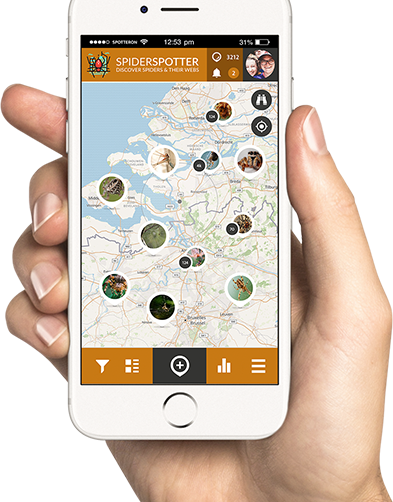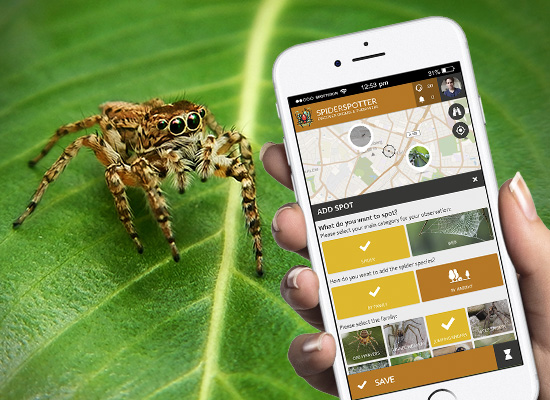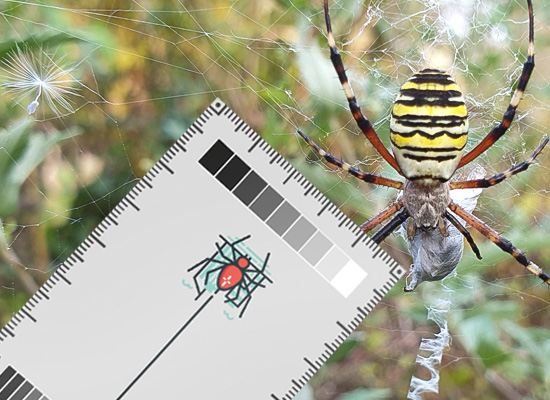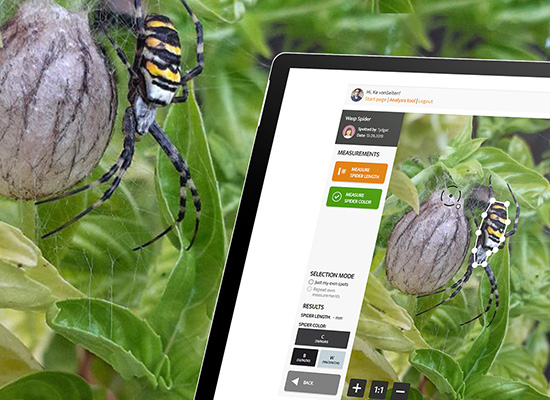
Download the SpiderSpotter App for Android or IOS and help with your observations!
Pirate otter spider (Pirata piraticus)
Web: wolf spiders don’t make a catching web, but are active hunters that use their legs and jaws to immobilize prey.
Habitat: occur in water-rich habitats such as around stagnant water (ponds, small lakes) and slow-running water (streams,… ) or at least in a moist environment (eg wet meadows).
How to recognize:
Looks similar to:
Size
♀: 4,5-9 mm
♂: 4-6,5 mm
When?
♀: May till August/September
♂: May till August/September
Spotted wolf spider (Pardosa amentata)
Web: wolf spiders don’t make a catching web, but are active hunters that use their legs and jaws to immobilize prey. The Spotted wolf spider hunts predominantly during the day.
Habitat: occurs in open habitat such as parcs, gardens, fields,… Mostly in rather humid conditions. Can be very frequent.
How to recognize:
Looks similar to:
Size
♀: 5,5-8 mm
♂: 5-6,5 mm
When?
♀: April till July
♂: April till July
Common fox spider (Alopecosa pulverulenta)
Web: wolf spiders don’t make a catching web, but are active hunters that use their legs and jaws to immobilize prey.
Habitat: Occurs in open habitas such as gardens, grassland clearings in woodland,… . Can be frequent.
How to recognize:
Looks similar to:
Size
♀: 5-8 mm
♂: 6,5-11 mm
When?
♀: April till July
♂: April till July
Platform hammock spider (Neriene peltata)
Web: Relatively thin sheetweb.
Habitat: Parcs and gardens, mainly in bushes.
How to recognize:
Looks similar to:
Size
♀: 3-5mm
♂: 2,2-3,5mm
When?
♀: May till July
♂: April till June
Herb hammock spider (Neriene clathrata)
Web: Relatively thin sheetweb.
Habitat: Many different habitats, such as roadsides, brushwood, parcs and gardens. Most often low to the ground. Adult males can often be found in litter.
How to recognize:
Looks similar to:
Size
♀: 3,7-5,5 mm
♂: 3,4-4,8 mm
When?
♀: throughout the year
♂: March till June
Spring hammock spider (Neriene montana)
Web: Often fairly large and robust sheet web. Most related species can be found hanging underneath the sheet part of the web, however, the Spring hammock spider can most often be found in a retreat (crevice, behind bark,…). The silk is more dens, closer to the retreat.
Habitat: Shaded areas, often against “dense” structures (hollow log, pile of branches, wall), less in “green” vegetation.
How to recognize:
Looks similar to:
Size
♀: 5-8mm
♂: 4-7mm
When?
♀: throughout the year
♂: April till June
Linyphia hortensis
Web: Sheetweb with ascending threads above the sheet and stabilizing threads underneath. Hangmatweb (thinner and smaller compared tot he European sheetweb spider)
Habitat: Parcs and gardens, often in higher grass, herbs and shrubs. Usually between 30 cm from ground level, ranging up to 2 m.
How to recognize:
Looks similar to:
Size
♀: 4-6mm
♂: 3-5mm
When?
♀: May till July
♂: April till June
European sheetweb spider (Linyphia triangularis)
Web: Sheetweb with ascending threads above the sheet and stabilizing threads underneath.
Habitat: not selective at all. Can be found in many different habitats, as long as there is a possibility to construct a web. Usually in vegetation, such as higher grass, herbs and shrubs. Usually between 30 cm from the ground, ranging up to 2 m.
How to recognize:
Looks similar to:
Size
♀: 5-7mm
♂: 4,6-7mm
When?
♀: From middle of August till end of October, sometimes until December. Lives longer than male
♂: From middle of August till end of October
Zoropsid spiders (Zoropsidae)
Spiny false wolf spider (Zoropsis spinimana)
Web: The Spiny false wolf spiders doesn’t make a web, but is an active and visual hunter.
Habitat: Mainly in and around houses. In Southern-Europe underneath stones, bark. Hunts at night.
How to recognize:
Looks similar to:
Size
♀: 10-19 mm
♂: 10-13 mm
When?
♀: throughout the year
♂: throughout the year
Cobweb spiders (Theridiidae)
Southern black widow (Latrodectus mactans)
Web: fairly large, 3D web with messy threads and often vertical threads with glue on the lower part towards the substrate (“gum footed threads”).
Habitat: The Southern black widow has not yet established permanent populations in Belgium. Observations are always the result of unintended hitchhiking from the original range (southern part of USA and Mexico). A lot of Southern black widow spiders are introduced by shipments of second-hand cars from USA in the Antwerp harbour.
How to recognize:
Looks similar to:
Size
♀: 15 mm
♂: 6 mm

Download the App on your smartphone now or open the map in your browser:
Do you want to help measuring spiders for science? Download the SpiderSpotter Card for self printing at home and hold it in the pictures you take in the SpiderSpotter App. With the measurement reference, we can determine the size of your spider or web observation better. You can also order it at spiderspotter@UGent.be, provide your address and the number of cards you need and we will send them to you!
When holding the SpiderSpotter Card near the spider or a spider's web, please make sure that a ruler and one of the brigthness gradient strips is visible in the picture. You can read more about how to take the pics in our info section!


With the new SpiderSpotter Data Analysis Tool, you can actively participate in generating scientific data! The online interface fetches spider observations live from the Citizen Science App and offers a range of tools to measure the size and the average colour of the spiders. Simply access the Data Analysis Tool and log in with your App account!
You can even select an option to just work with your observations from the App and export your measured data if you want to do your own analysis.